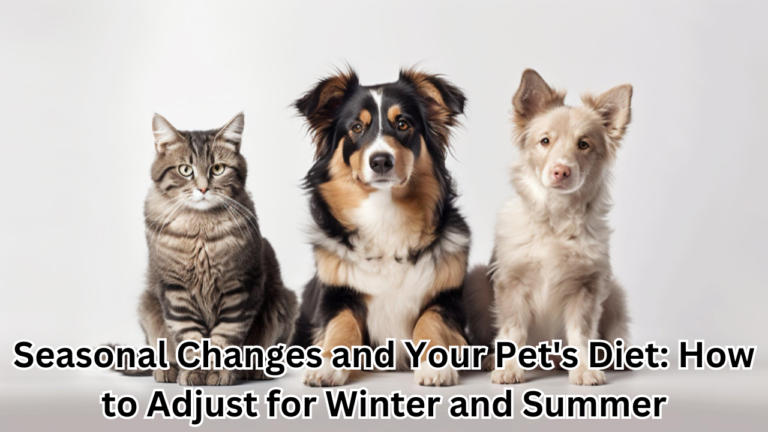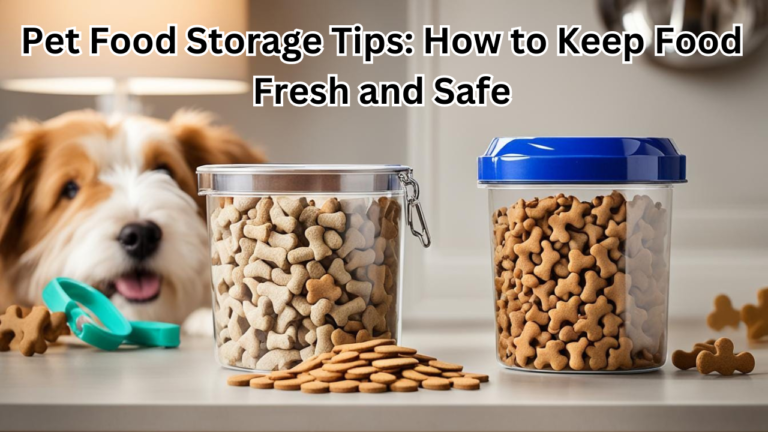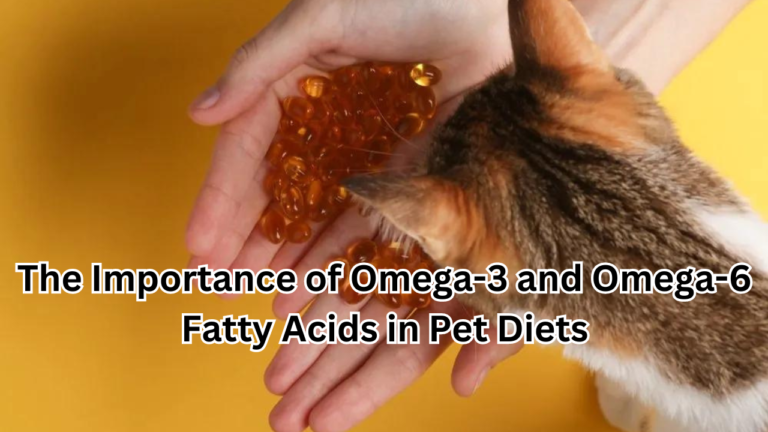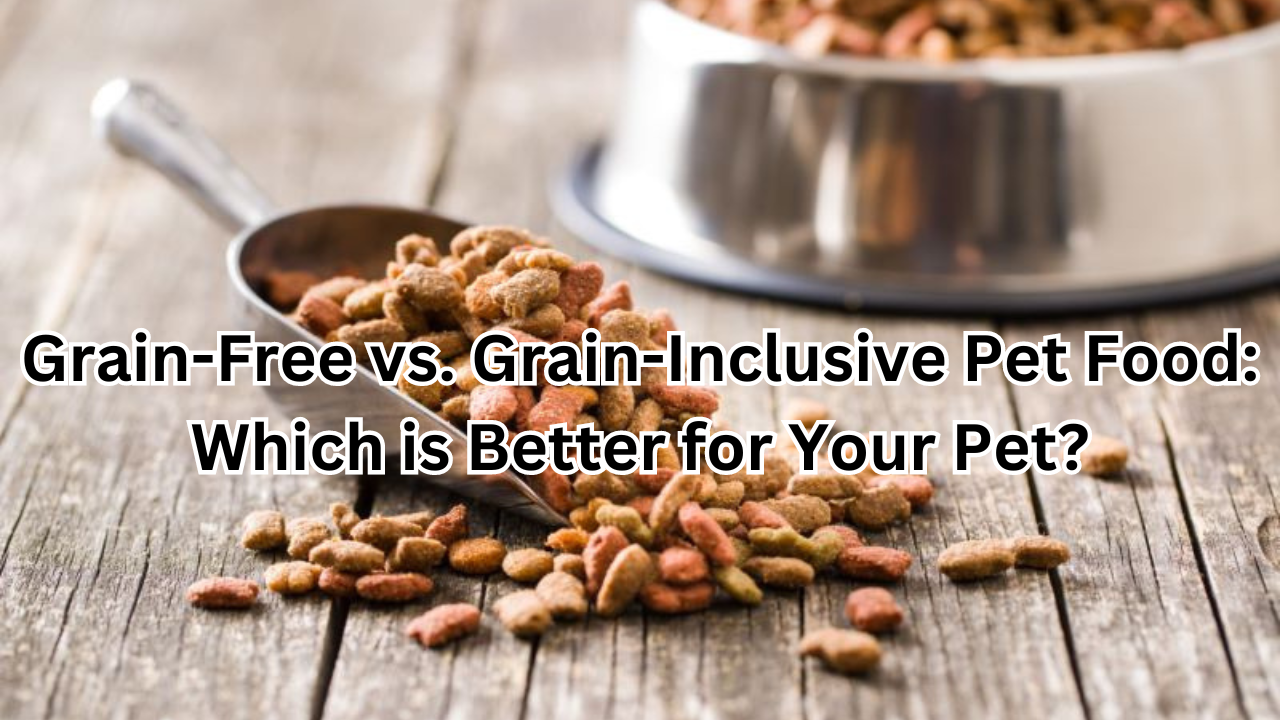
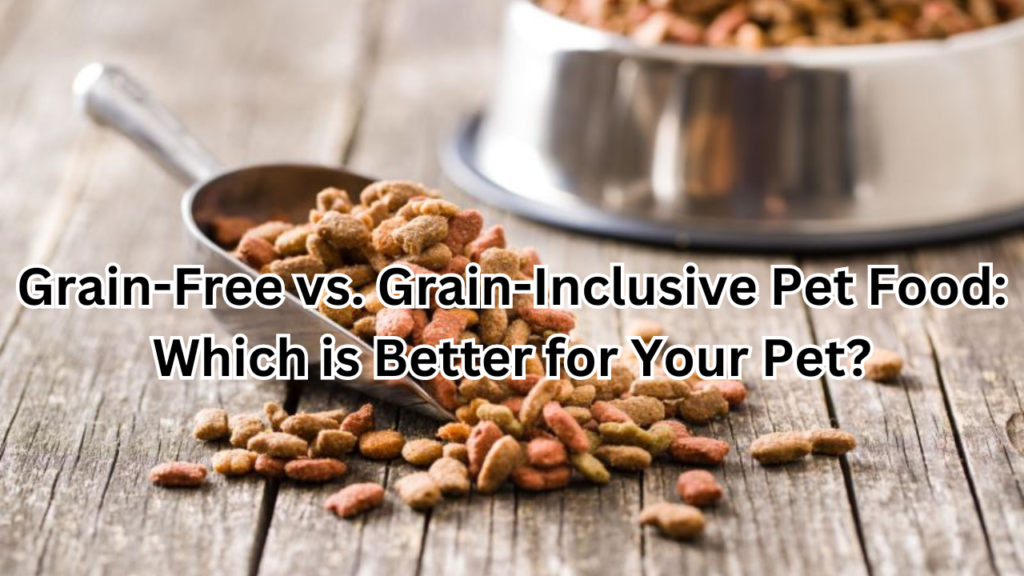
Table of Contents
Introduction
The Growing Debate in Pet Nutrition
In recent years, pet food choices have expanded significantly, with grain-free diets emerging as a popular alternative to traditional grain-inclusive options. This shift has sparked a growing debate among pet owners, veterinarians, and pet nutritionists. While some advocate for the benefits of grain-free diets, others emphasize the proven nutritional value of grains in pet food. As pet owners increasingly seek to make informed decisions about their pets’ diets, understanding the implications of these choices becomes crucial.
Purpose and Scope of the Article
This article aims to provide a comprehensive overview of the grain-free vs grain-inclusive pet food debate. We will explore the key differences between these dietary options, evaluate their potential benefits and drawbacks, and offer guidance on how to choose the best diet for your pet. By examining the latest research and expert opinions, we hope to equip pet owners with the knowledge they need to make informed decisions about their pets’ nutrition.
Why It Matters: Pet Health and Nutrition
Proper nutrition is fundamental to maintaining optimal health and well-being in pets. The right diet can influence everything from a pet’s energy levels and coat condition to their overall longevity. As the pet food industry continues to evolve, understanding the impact of dietary choices on your pet’s health becomes increasingly important. Whether you are considering switching to a grain-free diet or sticking with a grain-inclusive option, knowing the potential effects on your pet’s health can help you make the best choice for their needs.
Understanding Pet Food Categories
What is Grain-Free Pet Food?
Grain-free pet food refers to diets that do not include grains such as wheat, corn, barley, or rice. Instead, these formulations typically feature alternative sources of carbohydrates, such as sweet potatoes, peas, or lentils. The grain-free trend gained popularity due to concerns that grains might contribute to allergies or digestive issues in some pets. Proponents of grain-free diets argue that these foods more closely mimic the ancestral diets of dogs and cats, which were not naturally high in grains. Grain-free formulas often emphasize high-quality proteins and fats to provide balanced nutrition.
What is Grain-Inclusive Pet Food?
Grain-inclusive pet food, on the other hand, contains grains as a component of the diet. Grains such as brown rice, oats, and barley are included for their nutritional benefits, including fiber, vitamins, and minerals. These grains serve as a source of digestible carbohydrates that provide energy for pets. Grain-inclusive diets have been a traditional choice for pet owners due to their balanced approach to nutrition and their ability to support overall health. These foods are formulated to meet the dietary needs of pets with a blend of protein, fat, and carbohydrates.
Common Ingredients in Grain-Free Diets
Grain-free diets typically rely on a variety of alternative ingredients to replace grains. Some common ingredients in grain-free pet foods include:
- Sweet Potatoes: A nutritious source of carbohydrates, fiber, and vitamins.
- Peas and Lentils: Provide protein and fiber, and are rich in essential nutrients.
- Pumpkin: Offers fiber and beneficial vitamins, and supports digestive health.
- Chickpeas: A protein-rich legume that also contributes to fiber intake.
- Quinoa: Although technically a seed, quinoa is used in some grain-free diets as a nutrient-dense carbohydrate source.
These ingredients are chosen for their nutritional benefits and their ability to provide balanced energy without the use of traditional grains.
Common Grains Found in Pet Foods
In grain-inclusive pet foods, several grains are commonly used due to their digestibility and nutritional value:
- Brown Rice: A source of easily digestible carbohydrates and fiber, providing energy and supporting healthy digestion.
- Oats: Rich in fiber and nutrients, oats help promote healthy digestion and provide steady energy.
- Barley: Contains fiber, vitamins, and minerals, and supports overall health and digestive function.
- Corn: Often used as a source of energy and protein, although some pet owners prefer to avoid it due to concerns about allergens and digestibility.
- Wheat: Includes a mix of protein, fiber, and carbohydrates, but may be avoided by pets with specific allergies or sensitivities.
Nutritional Analysis
Macronutrient Comparison: Grain-Free vs Grain-Inclusive
When comparing grain-free and grain-inclusive pet foods, one of the most significant differences lies in their macronutrient profiles.
- Grain-Free Pet Foods: These diets often have higher protein and fat content, relying on meat, poultry, or fish as the primary sources of energy. Carbohydrates are provided by alternative sources such as sweet potatoes, peas, and lentils. This higher protein and fat content can be beneficial for pets requiring more energy or those with higher activity levels.
- Grain-Inclusive Pet Foods: These diets typically have a more balanced macronutrient profile, with a combination of proteins, fats, and carbohydrates from grains. The inclusion of grains adds digestible carbohydrates, which can provide steady energy and support overall health. The protein content in grain-inclusive foods may be slightly lower compared to grain-free options, but the inclusion of grains can help balance the diet with essential nutrients.
Micronutrient Benefits and Considerations
Micronutrients, including vitamins and minerals, are crucial for overall health and wellbeing. Both grain-free and grain-inclusive diets can be formulated to meet micronutrient requirements, but there are some considerations:
- Grain-Free Diets: Often fortified with vitamins and minerals to compensate for the absence of grains. Ingredients like sweet potatoes and peas provide some micronutrients, but additional supplementation may be needed to ensure a balanced intake.
- Grain-Inclusive Diets: Grains contribute vitamins such as B-vitamins (like thiamine and niacin) and minerals (such as iron and magnesium). These nutrients support various bodily functions, including energy metabolism and immune health. The inclusion of grains helps provide a natural source of these essential micronutrients.
The Role of Carbohydrates in Pet Diets
Carbohydrates play a critical role in providing energy and supporting overall health.
- Grain-Free Diets: These often use non-grain sources for carbohydrates, such as vegetables and legumes. While these sources can offer valuable nutrients, they may not always provide the same level of sustained energy as traditional grains. The carbohydrate content in grain-free diets may be lower, which could affect energy levels in some pets.
- Grain-Inclusive Diets: Grains such as rice, oats, and barley offer digestible carbohydrates that provide a steady energy supply. They also help maintain healthy digestive function and support overall health. The presence of grains in the diet ensures that pets receive a balanced supply of energy throughout the day.
Protein Content: How Do They Compare?
Protein content is a critical factor in pet nutrition, affecting muscle maintenance, immune function, and overall health.
- Grain-Free Diets: Typically contain higher levels of protein derived from animal sources such as meat, poultry, or fish. This high protein content can be beneficial for active pets or those with specific dietary needs. However, it is important to ensure that the protein sources are of high quality and easily digestible.
- Grain-Inclusive Diets: Generally offer a balanced protein content that may be slightly lower than grain-free options. The protein sources are often complemented by grains, which provide additional nutrients and energy. These diets aim to provide a well-rounded nutritional profile that supports overall health.
Fiber and Its Importance in Pet Nutrition
Fiber is essential for maintaining healthy digestion and overall wellbeing.
- Grain-Free Diets: May include sources of fiber such as peas, lentils, and sweet potatoes. While these ingredients provide fiber, the overall fiber content might vary depending on the specific formulation. Adequate fiber is important for digestive health and preventing issues like constipation.
- Grain-Inclusive Diets: Grains like brown rice and oats contribute significant amounts of fiber, which supports healthy digestion and helps regulate bowel movements. Fiber also aids in weight management by promoting a feeling of fullness and stabilizing blood sugar levels.
Health Implications
Potential Benefits of Grain-Free Diets
Grain-free diets are often touted for several potential benefits:
- Reduced Allergic Reactions: Some pets may be sensitive or allergic to certain grains, such as wheat or corn. A grain-free diet can help alleviate symptoms like itching, ear infections, or gastrointestinal distress in these pets.
- Improved Digestion: Grain-free diets often contain alternative sources of carbohydrates and fiber that can be easier on the digestive system. Ingredients like sweet potatoes and peas are generally well-tolerated and can support healthy digestion.
- Increased Protein and Fat: Many grain-free foods have higher levels of animal-based proteins and fats, which can be beneficial for active or working pets. This can help maintain muscle mass and energy levels.
- Enhanced Coat and Skin Health: The higher fat content in grain-free diets, often from sources like fish oil, can contribute to a healthier, shinier coat and better skin condition.
Risks Associated with Grain-Free Pet Food
Despite their potential benefits, grain-free diets also come with some risks:
- Nutritional Imbalances: Without careful formulation, grain-free diets may lack essential nutrients or may not provide a complete balance of proteins, fats, and carbohydrates. This can lead to deficiencies or imbalances if not properly addressed.
- Dilated Cardiomyopathy (DCM): Some studies have suggested a potential link between grain-free diets and an increased risk of DCM, a serious heart condition in dogs. This concern is still under investigation, but it highlights the importance of choosing high-quality, well-balanced grain-free options.
- Higher Cost: Grain-free pet foods can often be more expensive than grain-inclusive options due to the use of higher-quality ingredients and more specialized formulations.
Benefits of Grain-Inclusive Diets
Grain-inclusive diets also offer several benefits:
- Balanced Nutrition: Grains provide a steady source of carbohydrates, which help maintain consistent energy levels and support overall health. They also contribute essential nutrients and fiber.
- Digestive Health: The fiber from grains like brown rice and oats supports healthy digestion, preventing issues like constipation and promoting regular bowel movements.
- Cost-Effectiveness: Generally, grain-inclusive pet foods are more affordable than grain-free options, making them a cost-effective choice for many pet owners.
- Nutrient Enrichment: Grains can enrich the diet with important vitamins and minerals, such as B-vitamins, iron, and magnesium, which are beneficial for various bodily functions.
Common Health Concerns Linked to Grains
While grains can be beneficial, some health concerns are associated with their inclusion in pet diets:
- Food Allergies and Sensitivities: Some pets may have allergies or sensitivities to specific grains, leading to symptoms like itching, gastrointestinal upset, or ear infections.
- Digestive Issues: Pets with certain digestive conditions might struggle with the inclusion of grains, which can lead to discomfort or digestive disturbances.
- Potential for Overweight: Grains can contribute to higher calorie content, which might lead to weight gain if not managed properly, especially in less active pets.
Allergies and Food Sensitivities
Understanding allergies and food sensitivities is crucial in choosing the right diet for your pet:
- Grain Allergies: Some pets have genuine allergies to grains such as wheat or corn. In these cases, grain-free diets can help alleviate symptoms by eliminating the offending ingredients.
- Food Sensitivities: Pets may
experience sensitivities to certain grains, even if they are not allergic. These sensitivities can lead to digestive issues or skin problems. In such cases, a grain-free diet might be beneficial for reducing symptoms and improving overall comfort.
- Diagnosing and Managing Allergies: It’s important to work with a veterinarian to accurately diagnose food allergies or sensitivities. A proper diagnosis often involves an elimination diet to identify the specific ingredients causing the problem. Based on the results, a grain-free diet or a specialized grain-inclusive formula may be recommended.
- Balanced Approach: For pets with known food sensitivities, selecting a high-quality, hypoallergenic grain-free food or a grain-inclusive option that avoids the problematic grains can help manage their condition effectively. It’s essential to ensure that any diet chosen is nutritionally balanced and tailored to the pet’s specific health needs.
Industry Perspectives and Trends
The Rise of Grain-Free Pet Foods: Market Trends
The grain-free pet food market has seen significant growth over the past decade. Driven by increased consumer awareness and changing perceptions about pet nutrition, grain-free options have become a prominent segment in the pet food industry.
- Market Growth: The popularity of grain-free diets has led to a surge in the availability and variety of these products. Pet food manufacturers have responded by developing a wide range of grain-free formulas, often featuring high-protein ingredients and novel carbohydrates like sweet potatoes and peas.
- Consumer Demand: Consumers are increasingly seeking out grain-free options due to concerns about allergies, sensitivities, and perceived health benefits. This demand has been fueled by marketing claims that grain-free diets are more natural or closer to the ancestral diets of pets.
- Product Innovation: As competition in the grain-free market intensifies, brands are investing in research and development to create innovative formulations that meet the growing demand. This includes exploring alternative ingredients and improving nutritional balance.
Popularity of Grain-Inclusive Diets
Despite the rise of grain-free options, grain-inclusive pet foods remain popular and widely used.
- Traditional Preference: Many pet owners continue to prefer grain-inclusive diets due to their long-standing presence in the market and their proven effectiveness in providing balanced nutrition. Grains like rice and oats are known for their digestibility and nutritional benefits.
- Balanced Nutrition: Grain-inclusive diets are often valued for their well-rounded nutritional profile, which includes a mix of proteins, fats, and carbohydrates. This balance supports overall health and can be more affordable compared to premium grain-free options.
- Consumer Education: As awareness grows, pet owners are increasingly recognizing the benefits of grains in pet diets. This includes understanding that grains can offer essential nutrients and fiber that support digestive health and overall wellness.
Veterinary Opinions on Grain-Free vs Grain-Inclusive
Veterinary opinions on grain-free vs grain-inclusive diets vary, reflecting ongoing research and individual experiences.
- Grain-Free Diets: Some veterinarians support grain-free diets for pets with specific allergies or sensitivities. They emphasize the importance of choosing high-quality, well-balanced grain-free foods to avoid potential nutritional imbalances.
- Concerns and Cautions: There are concerns about the potential link between grain-free diets and dilated cardiomyopathy (DCM) in dogs. While research is still ongoing, some veterinarians recommend caution and suggest monitoring pets’ health closely when feeding grain-free diets.
- Balanced View: Many veterinarians advocate for a balanced approach, considering the individual needs of each pet. They may recommend grain-inclusive diets for pets without specific dietary sensitivities, highlighting the benefits of grains in providing a complete and balanced nutritional profile.
Consumer Preferences and Influences
Consumer preferences play a significant role in shaping the pet food market, influenced by various factors.
- Health Trends: Increasing awareness of pet health and nutrition trends has led consumers to seek out diets that align with their perceptions of what is best for their pets. This includes preferences for grain-free options due to concerns about allergies and a desire for “natural” diets.
- Marketing and Education: Pet food companies use marketing strategies to highlight the benefits of their products, whether grain-free or grain-inclusive. Educational campaigns, including informational packaging and advertising, influence consumer choices by emphasizing specific health benefits or addressing common concerns.
- Personal Experience: Many pet owners base their decisions on personal experiences or recommendations from veterinarians, friends, or online reviews. Positive feedback about a particular diet can drive consumer loyalty and influence purchasing decisions.
- Cost Considerations: Price is a significant factor in consumer decision-making. While grain-free diets are often more expensive, some consumers are willing to pay a premium for what they perceive as higher-quality or more beneficial options. Others may prioritize cost-effectiveness, leading them to choose grain-inclusive diets that offer good nutritional value at a lower price.
Cost Considerations
Price Comparison: Grain-Free vs Grain-Inclusive
When evaluating the cost of pet food, it’s essential to consider the price differences between grain-free and grain-inclusive options.
- Grain-Free Pet Foods: Generally, grain-free pet foods are more expensive than their grain-inclusive counterparts. This price difference is often due to the use of higher-quality ingredients, such as premium meats and alternative carbohydrate sources like sweet potatoes and peas. Additionally, the production and formulation of grain-free diets may involve more complex processes and higher-quality control standards.
- Grain-Inclusive Pet Foods: Grain-inclusive diets are typically more affordable. Grains like rice, oats, and barley are less expensive to source and produce compared to the alternative ingredients used in grain-free formulas. As a result, these diets can offer a cost-effective solution for pet owners seeking balanced nutrition without the higher price tag associated with grain-free options.
Budget-Friendly Options
For pet owners on a budget, there are several strategies to find cost-effective options without compromising on nutrition.
- Look for Quality Brands: Even within the grain-inclusive category, there are high-quality brands that provide balanced nutrition at a reasonable price. Researching and comparing different brands can help identify affordable options that meet your pet’s dietary needs.
- Buy in Bulk: Purchasing pet food in larger quantities or bulk packages can often reduce the cost per serving. Many pet food stores and online retailers offer discounts for bulk purchases, making it a budget-friendly option.
- Use Coupons and Discounts: Keep an eye out for coupons, promotions, and discounts offered by pet food brands or retailers. Signing up for newsletters or loyalty programs can provide access to special deals and savings.
- Consider Store Brands: Many pet food retailers offer store-brand or private-label options that are more affordable than premium brands. These products can offer comparable nutrition at a lower cost.
Long-Term Costs and Health Outcomes
When considering the cost of pet food, it is important to factor in long-term costs and potential health outcomes.
- Health Benefits and Vet Visits: Investing in higher-quality pet food, whether grain-free or grain-inclusive, can potentially reduce long-term health costs. A well-balanced diet may help prevent health issues, such as allergies, digestive problems, or obesity, which can lead to expensive veterinary bills. Good nutrition supports overall health and may reduce the frequency of vet visits or the need for medical treatments.
- Longevity and Quality of Life: Quality pet food can contribute to a longer and healthier life for pets. While grain-free diets may have higher upfront costs, they may offer benefits for pets with specific health concerns. Similarly, grain-inclusive diets can provide balanced nutrition that supports long-term health. Choosing a diet that meets your pet’s specific needs can positively impact their quality of life and longevity.
- Potential for Health Issues: It’s important to consider that feeding your pet a diet that is not well-suited to their health needs may result in health issues that could incur additional costs. For instance, a grain-free diet might be necessary for pets with grain allergies, while a grain-inclusive diet might be appropriate for those without such sensitivities.
Making the Right Choice for Your Pet
Assessing Your Pet’s Specific Needs
Choosing the right diet for your pet involves understanding their individual needs and health requirements. Here are key factors to consider:
- Age and Life Stage: Puppies, adult dogs, and senior pets have different nutritional needs. Puppies and kittens require higher levels of protein and calories for growth, while senior pets might need a diet that supports joint health and maintains a healthy weight.
- Health Conditions: Pets with specific health conditions, such as allergies, diabetes, or kidney disease, may benefit from specialized diets. Grain-free diets might be necessary for pets with grain sensitivities, while grain-inclusive diets can provide balanced nutrition for those without such issues.
- Activity Level: An active pet or working animal may require a higher protein and fat content to support their energy needs, whereas a less active pet might need a lower-calorie diet to prevent weight gain.
- Weight Management: If your pet is overweight or underweight, selecting a diet with the appropriate calorie content and nutritional balance is crucial. Some grain-free diets are higher in fat, which may not be suitable for weight management, while some grain-inclusive options can offer balanced calories.
Consultation with a Veterinarian
Consulting with a veterinarian is an essential step in choosing the right diet for your pet:
- Professional Advice: A veterinarian can provide tailored recommendations based on your pet’s health history, current condition, and dietary needs. They can help determine whether a grain-free or grain-inclusive diet is best suited for your pet’s specific requirements.
- Nutritional Guidance: Veterinarians can advise on appropriate brands and formulations, ensuring that the chosen diet meets all of your pet’s nutritional needs. They can also address any concerns about potential health issues associated with different diets.
- Health Monitoring: Regular veterinary check-ups allow for monitoring of your pet’s health and diet-related effects. Your vet can track changes in weight, coat condition, and overall health, and adjust dietary recommendations as needed.
Transitioning Between Diets Safely
When changing your pet’s diet, whether switching between grain-free and grain-inclusive or altering brands, a gradual transition is key:
- Gradual Introduction: To prevent digestive upset, gradually introduce the new food over a period of 7 to 10 days. Start by mixing a small amount of the new food with the old food, gradually increasing the proportion of the new food each day.
- Monitor for Reactions: During the transition, observe your pet for any adverse reactions, such as changes in stool consistency, vomiting, or signs of discomfort. If any issues arise, consult your veterinarian for advice.
- Consistency: Ensure that the new diet is consistent with your pet’s specific nutritional needs and preferences. A sudden change in diet can lead to digestive disturbances or reluctance to eat.
Monitoring Your Pet’s Health and Diet Impact
After transitioning to a new diet, ongoing monitoring is essential to ensure that it is benefiting your pet:
- Health Observations: Pay attention to changes in your pet’s coat condition, energy levels, weight, and overall health. A positive response to the new diet might include improved coat shine, stable weight, and increased vitality.
- Regular Check-Ups: Schedule regular veterinary visits to assess your pet’s health and evaluate the impact of the new diet. Your vet can perform routine exams, lab tests, and provide feedback on how the diet is affecting your pet’s wellbeing.
- Adjustments as Needed: Based on your observations and veterinary feedback, be prepared to make adjustments to the diet if necessary. This could involve changing brands, adjusting portions, or switching to a different type of diet based on your pet’s evolving needs.
Summary
Recap of Key Points
In evaluating whether grain-free or grain-inclusive pet food is better for your pet, several crucial factors come into play:
- Understanding Pet Food Categories: Grain-free pet foods omit traditional grains and often use alternative carbohydrates like sweet potatoes and peas. In contrast, grain-inclusive diets include grains such as rice, barley, and oats, which provide essential nutrients and fiber.
- Nutritional Analysis: Grain-free diets typically feature higher levels of protein and fat, which can benefit active pets but may also carry risks if not properly balanced. Grain-inclusive diets offer a more traditional balance of carbohydrates, proteins, and fats, contributing to overall digestive health and sustained energy.
- Health Implications: Grain-free diets may offer benefits for pets with specific allergies or sensitivities, but they also come with risks, including potential links to heart conditions like dilated cardiomyopathy. Grain-inclusive diets provide balanced nutrition but may not be suitable for pets with grain allergies or sensitivities.
- Industry Perspectives and Trends: The market for grain-free pet foods has expanded significantly due to consumer demand and perceived health benefits. However, grain-inclusive diets remain popular due to their affordability and proven nutritional balance.
- Cost Considerations: Grain-free pet foods generally come at a higher price point, reflecting the cost of premium ingredients. Budget-friendly options and considerations for long-term health and costs can guide pet owners in making cost-effective choices.
- Making the Right Choice for Your Pet: Assessing your pet’s specific needs, consulting with a veterinarian, transitioning diets safely, and monitoring health impacts are essential steps in selecting the appropriate diet.
Final Recommendations
When choosing between grain-free and grain-inclusive pet food, consider the following recommendations:
- Evaluate Your Pet’s Needs: Take into account your pet’s age, health conditions, activity level, and weight. Choose a diet that meets their specific nutritional requirements and supports their overall health.
- Consult a Veterinarian: Seek professional advice to make an informed decision. Your veterinarian can provide personalized recommendations based on your pet’s health history and dietary needs.
- Monitor and Transition: If switching diets, do so gradually to minimize digestive disturbances. Monitor your pet’s health closely during the transition and adjust as needed based on their response.
- Balance Cost and Quality: While grain-free diets may offer benefits for certain pets, consider the cost implications and explore budget-friendly options that provide high-quality nutrition. Grain-inclusive diets can be a cost-effective alternative, offering balanced nutrition without compromising quality.
- Stay Informed: Keep abreast of new research and industry trends related to pet nutrition. Understanding evolving perspectives and product offerings can help you make the best choices for your pet’s health.
Frequently Asked Questions (FAQs)
Is Grain-Free Food Better for Dogs with Allergies?
Grain-free food may be beneficial for dogs with allergies, particularly if the allergies are linked to grains. Common grains like wheat, corn, and soy can sometimes cause allergic reactions or sensitivities in dogs, leading to symptoms such as itching, digestive issues, or ear infections. A grain-free diet eliminates these potential allergens and can be a useful option for managing such conditions.
However, not all allergies are grain-related. It’s important to identify the specific allergen causing your dog’s symptoms, which often requires veterinary testing. Grain-free diets should be chosen based on a vet’s recommendation and after confirming that grains are indeed the allergen.
Can Cats Thrive on a Grain-Free Diet?
Cats can thrive on a grain-free diet, provided that it meets their nutritional requirements. Unlike dogs, cats are obligate carnivores, meaning their diet should be high in animal protein and fat. Grain-free cat foods often emphasize meat-based ingredients, which align with a cat’s natural dietary needs.
As with any diet, the key is to ensure that the grain-free food is nutritionally complete and balanced. Cats have specific dietary requirements, including certain amino acids and vitamins that must be present in their food. Consult with a veterinarian to ensure that the grain-free diet you choose is appropriate for your cat’s health and nutritional needs.
Are There Any Risks to Grain-Inclusive Diets?
Grain-inclusive diets are generally considered safe and nutritionally balanced for most pets. However, there are a few considerations to keep in mind:
- Allergies and Sensitivities: Some pets may have allergies or sensitivities to specific grains, which could lead to digestive issues or skin problems. It’s essential to choose a high-quality grain-inclusive food and monitor your pet for any adverse reactions.
- Nutritional Balance: Ensure that the grain-inclusive diet provides a balanced mix of protein, fat, and carbohydrates. Poor-quality grains or imbalanced formulas can lead to nutritional deficiencies or health issues.
- Misconceptions: While some grain-inclusive diets are criticized for being less “natural,” grains can be a valuable source of nutrients and fiber. Quality control and ingredient selection are crucial for avoiding potential risks.
How Do I Know if My Pet Has a Grain Allergy?
Determining if your pet has a grain allergy involves a few steps:
- Observe Symptoms: Common symptoms of food allergies in pets include itching, ear infections, digestive upset (vomiting, diarrhea), and skin issues. Note any patterns related to diet changes.
- Elimination Diet: A veterinary-supervised elimination diet can help identify specific allergens. This involves feeding a diet with novel proteins and carbohydrates (often grain-free) and gradually reintroducing potential allergens to observe reactions.
- Veterinary Testing: Consult your veterinarian for diagnostic tests. While blood tests and skin tests are available, they are not always definitive. A thorough evaluation and history are essential for accurate diagnosis.
What Should I Look for on Pet Food Labels?
When evaluating pet food labels, consider the following:
- Ingredients List: Look for high-quality protein sources (e.g., chicken, beef) and avoid vague terms like “meat by-products.” Check for any specific ingredients your pet may be sensitive to or that are not appropriate for their condition.
- Nutritional Adequacy Statement: Ensure the food meets the standards set by the Association of American Feed Control Officials (AAFCO) or equivalent regulatory body. This statement indicates that the food is nutritionally complete and balanced.
- Guaranteed Analysis: This section provides information on the levels of key nutrients (protein, fat, fiber, moisture). Verify that these levels are appropriate for your pet’s life stage and health needs.
- Specific Claims: Be cautious with marketing claims such as “grain-free,” “natural,” or “holistic.” Ensure these claims are supported by the nutritional content and ingredient quality.
- Expiration Date: Check the expiration date to ensure the food is fresh and has not deteriorated, which can affect its nutritional value and safety.
